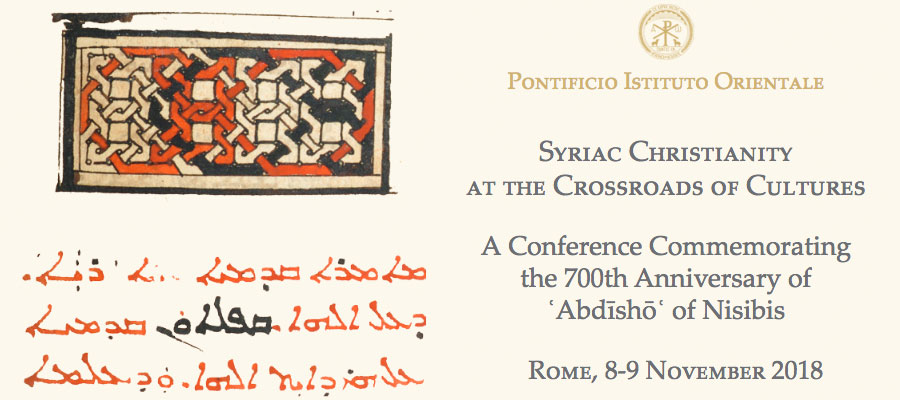Syriac Christianity at the Crossroads of Culture: A Conference Commemorating the 700th Anniversary of Abdisho of Nisibis, Pontificio Istitito Orientale, Rome, November 8–9, 2018
The ancient churches of the Middle East have long attracted the interest of scholars in the West. Yet the danger currently posed to them has occasioned renewed attention from mainstream audiences. One point of interest has been the Syriac tradition, once referred to by Sebastian Brock as the ‘third lung’ of Christianity (alongside the better-known Latin and Greek traditions). Embodying the tradition is the Church of the East, known variously throughout history as ‘Nestorian’ and ‘East Syrian,’ and which today refers to itself as the Assyrian Church of the East. With its historic base in Iraq, the Church of the East once constituted a vast, global entity that spread as far west as Cyprus and as far east China, and produced several prominent thinkers throughout the Middle Ages, some of whom were instrumental in the transmission of Greek thought into the Islamic world. Alongside its Chaldean Catholic counterpart, the Church of the East of today maintains a strong presence in northern Iraq and Iran, eastern Syria, and southern India, with diasporas across Europe, Australia, and North America.
Arguably the most important author from this tradition is the polymath ʿAbdīshōʿ bar Brīkhā (d. 1317), metropolitan of the ancient See of Nisibis. He flourished in a period of literary efflorescence known as the Syriac Renaissance—an era marked by an openness to Islamic philosophy, science and literature—and wrote works in both Syriac and Arabic. He excelled in several ecclesiastical disciplines including religious poetry, theology, apologetics, and canon law, and is even known to have written on alchemy and other esoterica. His famous Catalogue of Ecclesiastical Writers enabled early modern orientalists to reconstruct the history of Syriac literature, and continues to be mined for information by scholars. More importantly, ʿAbdīshōʿ’s popularity has endured among members of the Church of the East, who regard him as one of their most foundational theologians, poets, and canonists.
Yet, for all his importance, ʿAbdīshōʿ’s works have been scarcely studied in wider disciplines. This conference will discuss ʿAbdīshōʿ’s significance for Syriac studies and adjacent subjects. In addition to discussing ʿAbdīshōʿ himself, papers will touch on his Syriac Christian, Armenian, and Muslim contemporaries. In doing so, we aim to throw light on the multi-lingual and multi-religious environment that shaped this remarkable figure’s ‘thought-world.’ Attention will also be paid to ʿAbdīshōʿ’s legacy and reception in later centuries, with focus on the manuscript tradition, editions, and translations of his works. By marking the 700th anniversary of ʿAbdīshōʿ’s death this conference hopes to open the field of late medieval Syriac and Christian Arabic studies to a wider audience, and discuss prospects for future research and collaboration across subject areas.
